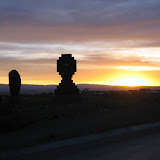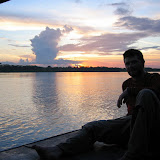At noon last Tuesday I received an email: there was a raft race on the Amazon and a team needed an extra man. They were flying out the following morning at 5AM and I could step in if I could jump on fast enough.
Of course I jumped.
I flew to Iquitos the next day and crashed at the house of a team member for the night before starting what promised to be an adventure of epic proportions.
It is called the
Great River Amazon Raft Race and brags about being the world's longest raft race at ~132 miles. The rules are simple: each 4 person team gets 8 logs and some jungle vines and makes their own rafts, then for 3 days they paddle down the Amazon River, stopping at a village called Porvenir the first night and a town called Tamshiyacu the second night.
View Larger MapMy team was Proyecto Dengue 1 (Project Dengue); it consisted of Amy, an entomologist who studies Dengue Fever and the mosquitos that spread it in affiliation with the US Navy and UCSD, Jackie, a grad student in entomology working with Amy, and Rod, a British physician who has been working on tuberculosis ventilation systems in Peru for a few years. Proyecto Dengue 2 consisted of 4 Peruvian field workers that work with Amy.
We collected big balsa logs from a boat then started whacking away at the ends of the logs with our little machete. Then a Mr. W, who lived across the river from the beach we were building the rafts on, showed up with an axe and offered to help us build our raft; after that he pretty much took over. Our unique design was to have a catamaran such that we could paddle in the center when paddling on the outside got tiring; Rod also very wisely thought to bring some lawn chairs, which we chopped down to size and then carved holes for and lashed them down in the back. I think it's fair to say that we had the most daring design.
Before the race even started, we had 2 people go to the hospital. One Australian gentleman who was in the race got stung by a stingray walking from the support boat to shore (the support boat was a double decker boat where we hung hammocks on the open top floor to sleep and below was storage); he needed to go to the hospital for anti venom. The second was a pretty British gal who had a nasty case of food poisoning.
Day 1: Saw what we thought was a
kingfisher & lots of dolphins; the Amazon is one of the few places in the world with
freshwater dolphins called Boto, some of which are a bright pink. We were thankful that it was cloudy, but I learned a lesson:
just because it's cloudy doesn't mean that the sun has gone away- the proof is that I burned the heck out of my feet, resulting in a fine "Irish suntan."
Overall spent about 7.5 hours rowing and we were all pretty hurting by the end. We stopped in the little village of Porvenir, which was basically a few community buildings surrounding a distillery where "Agua Arriente" or firewater was made from sugarcane- that stuff packs some punch I can tell you! We heard that another team had seen a poisonous water snake swimming along as well. It was great to get to know the stories of some of the international teams- there were representatives from at least Australia, the US, Canada, Mexico, Germany, Switzerland, Holland, and Tasmania (apologies if I'm forgetting some). There were the 4 funny guys from the US doing Peace Corps in Ecuador, the 4 Tasmanian river guides who said that this trip was as long as their entire island, the ringer team from Mexico-Germany-Canada-US who do competitive paddling and were clearly going to win for the international teams, the backpacker teams who met each other for the first time while building rafts, and others. It was relieving to hear from the Tasmanian river guides that the river was almost impossible to read and that they were going from competitive mode to enjoy the ride mode- made us feel better about ourselves, even though we finished a respectable 3rd place for the international teams on the day.
Day 2: This was the longest day at about 9.5 hours on the river. The coast guard actually had to go out looking for 2 late rafts after dark and so some towing. Now everybody knows that the
Amazon River is long, but it really is an added challenge that it is so wide. In most places it seemed to be wider than the lakes I know from back in the US, and if I had to guess I'd bet that it was more than a half mile wide in most parts. This is frustrating because you have no point of reference to give you a sense of movement- you paddle for hours around these huge bends and can't tell if you're going forward or sideways or backwards. We were, luckily, able to take a somewhat narrower route in which the current seemed to move a bit faster and where the river was close enough that we felt we were trucking. We spent the night in the town of Tamshiyacu, where they had paved roads and the town actually put on a big performance with the school children in honor of us and then threw a party, which was great.
Day 3: We were all pretty tired by this point and the muscles were just feeling toasted. After 7 something hours, we reached the home stretch- an upstream paddle to the finish (the city of Iquitos is on a tributary of the Amazon River, which we had to paddle up). There were tons of local kids playing in the water to greet us (and snag a bit of a free ride) and a good turnout at the local boating house to see the end to this interesting endeavor. It was kind of abrupt to be leaving our little raft and the excellent company of Proyecto Dengue 1, but it was nice to give the arms and back a rest. It really hit me that the race was over when D, who was our support person and looked out for us, handed me a much appreciated cold beer.
This is one of those things you get to do once in your life, if you're lucky, and I feel very fortunate to have been a part of it.
Click on my photo below to go to my Picasa album, which has images linked to a map and high resolution photos.





















































